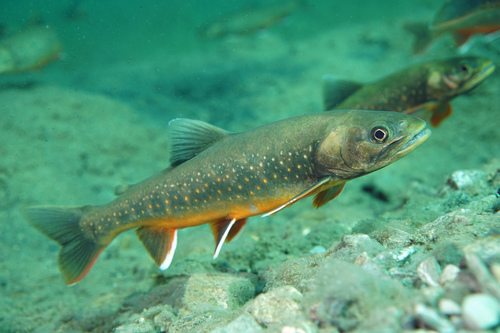
Arctic char
The Bluefin Tuna, belonging to the genus Thunnus, is a highly migratory species. Known for its remarkable size, speed, and commercial value, the Bluefin Tuna plays a crucial role in marine ecosystems and human economies. This article provides a comprehensive look at this magnificent fish.
5 40 years
Lifespan
40 - 80 cm
Length
Least Concern
Conservation Status
25 km/h
Swimming speed
Carnivorous, Insectivorous
Diet
Anadromous, Local Migration
Migration
Appearance Overview
The Bluefin Tuna is renowned for its large, streamlined body, built for speed and endurance.
Color
Dark metallic blue on top, with a silvery-white underside
Fins
Two dorsal fins, the first depressible into a groove; small, yellow finlets running from the second dorsal and anal fins to the tail
Body Shape
Torpedo-shaped, designed for efficient swimming
Length
Up to 13 feet (4 meters)
Weight
Up to 2,000 lbs (907 kg)
Diet
Carnivorous, feeding on a variety of fish, squid, crustaceans, and occasionally, on plankton and other small organisms.
Feeding Behavior
An opportunistic predator, the Bluefin Tuna uses its speed and agility to hunt. It often participates in coordinated feeding, herding prey or attacking in groups.
Social Behavior
Highly migratory, forming large schools, sometimes segregated by size. They exhibit complex social behaviors, particularly during spawning.
Commercial Relevance
Extremely high value, especially in sushi and sashimi markets, where its fatty flesh is considered a delicacy.
Conservation measures
International fishing quotas, catch limits, and monitoring programs. Some regions have implemented tuna farming to reduce pressure on wild stocks.
Status
Varies by species: Atlantic Bluefin - Endangered; Pacific Bluefin - Vulnerable; Southern Bluefin - Critically Endangered
Threats
Overfishing is the primary threat. Other factors include bycatch in fishing gear, habitat degradation, and the impacts of climate change on prey availability.
Habitat Distribution
Depth Range
0-1,000 meters, though they are most commonly found in the upper few hundred meters.
Geographic Range
Atlantic, Pacific, and Southern Oceans. Specific ranges vary by species (e.g., Atlantic, Pacific, Southern Bluefin).
Preferred Environment
Temperate and subtropical waters; pelagic (open ocean) environments.
Reproduction and Life Cycle
Breeding Habits
Spawns in specific areas, such as the Mediterranean Sea and the Gulf of Mexico for Atlantic Bluefin. Spawning typically occurs in warm waters.
Development Stages
Eggs hatch into larvae, which develop rapidly in plankton-rich waters. Juveniles grow quickly, reaching significant size within their first few years.
Fecundity
Females are highly fecund, capable of producing millions of eggs per spawning season (up to 30 million eggs).
Maturity Age
Varies by species; Atlantic Bluefin Tuna typically mature between 4-8 years.
Faqs about Arctic char
How fast can Bluefin Tuna swim?
Bluefin tuna are among the fastest fish in the ocean, capable of bursts of speed up to 43 mph (70 km/h).
What is the lifespan of a Bluefin Tuna?
They can live up to 40 years, though the average lifespan varies depending on the species and environmental conditions.
Is it safe to eat Bluefin Tuna?
Yes, but consumers should be aware of the conservation status of different Bluefin species and choose sustainably sourced options when available.
Are Bluefin Tuna warm-blooded?
Bluefin Tuna are warm-blooded, unlike most fish, allowing them to maintain a higher body temperature than the surrounding water, which aids in muscle efficiency.
What are the predators of Bluefin Tuna?
Besides humans, large sharks and killer whales are among the few predators of adult Bluefin Tuna.
How far do Bluefin Tuna migrate?
They undertake extensive migrations across oceans for feeding and spawning, often covering thousands of miles.
Copyright @ Nature Style Limited. All Rights Reserved.
 English
English